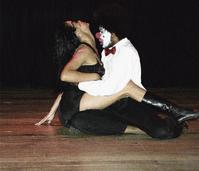Michael Robinson, Gleaner Writer
Dancing duo André Robinson (right) and Noelle Kerr perform at the Philip Sherlock Centre for the Creative Arts as part of KOTE celebrations.
KINGSTON ON The Edge (KOTE) is an annual art festival still in its infancy. Even so, all indications are that the recently concluded celebration of creativity was a resounding success. Since almost all the events were free, there are no receipts to be tallied, but there are far more important ways to measure the success of an event like this.
Last year, music, the spoken word and an array of visual art forms were the substance of the festival. This year saw dance and theatre being added to the roster, which involved about two dozen venues and scores of artists.
The second staging of what is now Jamaica's largest art festival pulled a substantially larger turnout than the inaugural edition.
synergistic energy
Scheduled to coincide with the summer solstice, or midsummer, which marks the start of the year's hottest season, KOTE has a synergistic energy that seems to resonate with people. "It has grown so much more than I expected," gushes Enola Williams, one of the founders and organisers of the festival. "Overall, the response has been better. People were really happy with the level of material presented."
The project was a culmination of the tireless efforts of a group that, along with Williams, includes Omar Francis, Carolyn Lazarus, Beatriz Pozueta and Joaquin 'Kinny' Portocarero. A shared passion for all things art brought the group together and fuelled them through the sleepless nights and challenging days needed to pull KOTE together. "Last year people didn't really know what to expect," says Kinny. "This year they knew what to expect and they were looking forward to it. For us, it was a challenge to see if we could pull it off again." And they did.
From uptown to downtown, KOTE showcased creativity in previously unseen formats, like a concert in a 200-year-old synagogue and a film series at Marcus Garvey's former headquarters. Two galleries were launched, one in a converted industrial building, and there was a capoeira show at the National Gallery of Jamaica. Capoeira is a physical art form that originated in Brazil. Resembling a cross between martial arts, dance and a game, it was invented by slaves.
giving the unexpected
"The name edge is pushing you to go even further," says Williams, "so you always want it to be slightly different and to give something unexpected. It's also the edge of something great because it has inspired a lot of people to be excited about being in Kingston and dealing with art."
There was a drum circle, a jazz concert, a blues session and even dramatic stage presentations. 'Theatre on the Edge' gave audiences a series of productions that spoke to a variety of topics not usually addressed in local theatre. KOTE seems to have inspired artists and patrons alike.
One patron, Omar Chedda, a self-described art lover who attended many of the KOTE events, says, "It was excellent. It highlighted an aspect of Jamaican culture that doesn't normally get a lot of attention, a side I like to call 'alternative'." He adds that he'd like to see more promotions next year so more people can know about the festival. "Not a lot of people know about the different art forms that exist here," he says.
Originally tagged as an 'underground' happening, KOTE's organisers aren't averse to growth. They are more concerned with staying true to the roots of the concept which has a non-commercial focus on promoting the arts.
plans for next year
While remaining tight-lipped about ideas for next year, Enola admits, "We'd like to be able to have a catalogue of everyone in the show, something substantial. This year we have video footage of the events and we'd like to do something with that."
Although nothing is set in stone at this point, Kinny alludes to the possibility of offshoot projects. "I would love to see a magazine come out," he muses, "something that would come out may be quarterly to keep the juices flowing for next year."
Positive and enthusiastic feedback - including requests to have stagings in other parts of Jamaica - illustrate a thirst for more of what KOTE brings. The organisers even received international calls from artists wanting to get involved, but unable to afford the plane fare. As time goes on, the challenge might be balancing growth with a desire to remain "as inclusive as possible" while keeping the arts - and 'hidden' talent in particular - as a central focus.
"What's really great," she continues, "is the possibilities are endless in terms of what can happen with it and different things we can experiment with. Because KOTE is about experimentation, new media and just a different approach to the arts."

